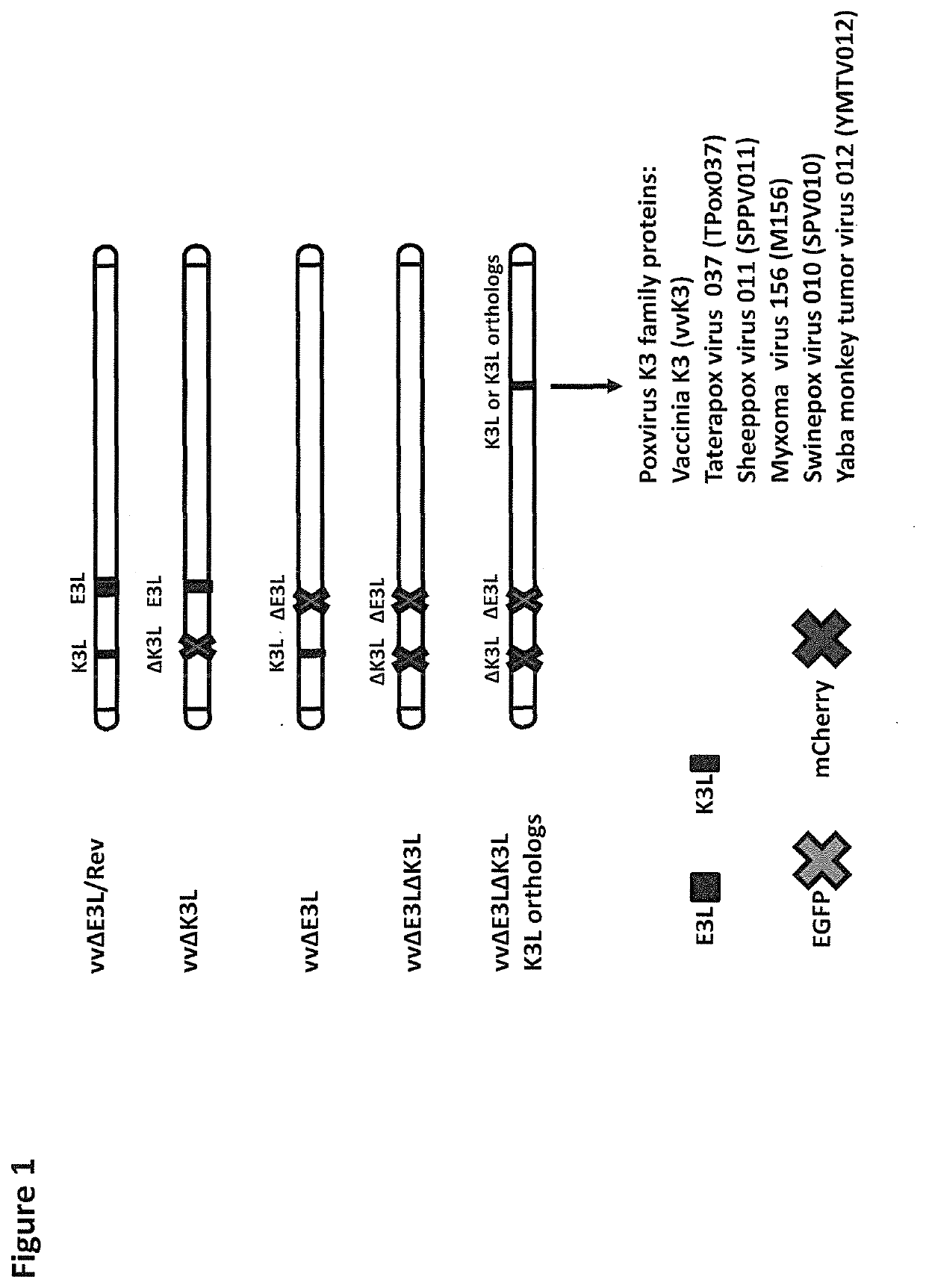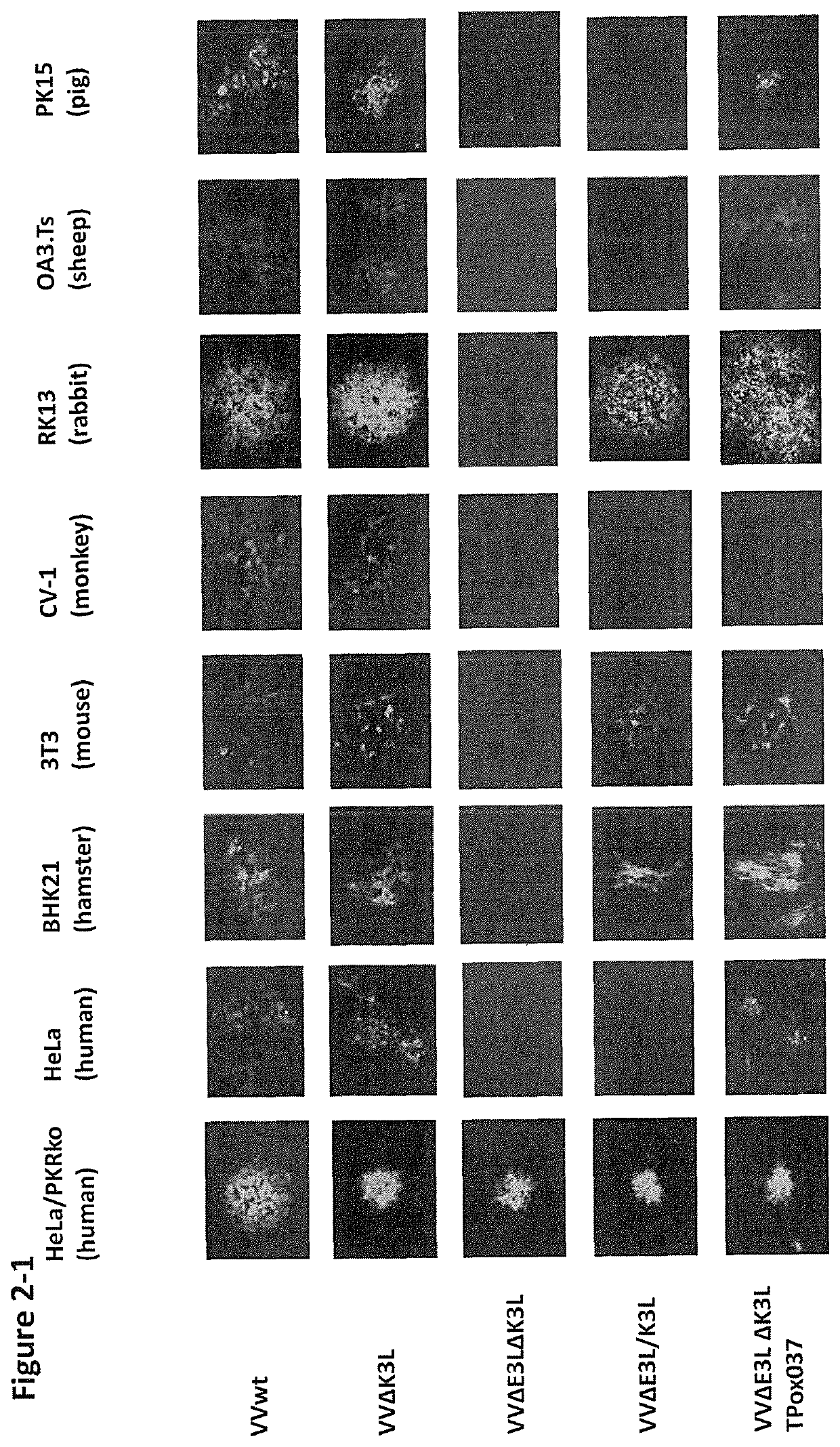Poxvirus Host Range Protein K3 as a Positive Selection Marker for Generation of Recombinant Poxviruses, a Therapeutic Target for Poxvirus Infection and a Therapeutic Agent for PKR Related Diseases
a technology of host range protein and poxvirus, which is applied in the field of poxvirus host range protein, can solve the problem of limiting the application of recombinant poxviruses to human vaccines and/or therapeutics
- Summary
- Abstract
- Description
- Claims
- Application Information
AI Technical Summary
Benefits of technology
Problems solved by technology
Method used
Image
Examples
example 1
nt Virus Construction
[0163]All the recombinant viruses discussed herein are shown in FIG. 1. Using standard homologous recombination technique, we disrupted the E3L (VVΔE3L) and K3L (VVΔK3L) genes individually by the insertion of EGFP gene into the wild-type vaccinia Western Reserve virus (vvWR) using BHK 21 cells. Based on the VVΔE3L, we further disrupted the K3L gene and created an E3L and K3L double deletion mutant (VVΔE3LΔK3L) using a human cell HeLa PKR deletion cell line. Based on the VVΔE3LΔK3L, K3 orthologs from six different poxviruses, including vaccinia K3, taterapox virus 037 (TPox037), sheeppox virus 011 (SPPV011), Myxoma virus 156 (M156), swinepox virus 010 (SPV010) and Yaba monkey tumor virus 012 (YMTV012), were inserted into vaccinia A45R locus (non-essential for the virus both in vitro and in vivo) under the control of vaccinia K3L promoter. The selection of the recombinant vaccinia virus (VVΔE3LΔK3L / K3 ortholog) was done in the cell lines as follows: BHK21 (baby ha...
example 2
on of the Recombinant Vaccinia Viruses Expressing Poxvirus K3 Orthologs
[0164]The replication of the VVΔE3LΔK3L viruses expressing poxvirus K3 orthologs was examined in cell lines derived from seven different animal species: HeLa (human), BHK21 (hamster), NIH / 3T3 (mouse), CV-1 (monkey), RK13 (rabbit), OA3.Ts (sheep) and PK15 (pig). As shown in FIG. 2, the wild-type vaccinia virus (expressing EGFP) and vvΔK3L replicated in all the cell lines tested. Furthermore, all the viruses replicate in the HeLa cells, in which the PKR gene was disrupted (HeLa / PKRko). The double deletion mutant (VVΔE3LΔK3L) could only replicate in HeLa / PKRko cells. Vaccinia K3 and its orthopoxvirus ortholog TPox037 could restore the replication of VVΔE3L in RK13 and the two rodent cell lines (BHK21 and 3T3), while TPox037, but not vaccinia K3, could mediate the virus to grow in HeLa, OA3.Ts and PK15 cells (FIG. 2). The K3 orthologs from four highly host restrictive poxviruses (sheeppoxvirus / sheep, myxoma / rabbit, s...
example 3
K3 Orthologs Mediated PKR Degradation Through Neddylation Dependent Pathway
[0165]Since poxvirus K3 family proteins share important amino acid sequence homology with eukaryotic initiation factor 2a (eIF2α) (which is a substrate for protein kinase R (PKR)), it has been assumed that poxvirus K3 proteins inhibit PKR function by acting as a pseudo-substrate for PKR. However, as discussed herein, it has been demonstrated that this is not correct.
[0166]The effect on PKR activation by the three poxvirus K3 proteins able to mediate the virus replication in human cells (HeLa) as shown in FIG. 2, was investigated. HeLa cells were investigated with the selected virus at a high multiplicity of infection (moi) of 10 and the cell lysate was collected at several time points, 3, 6, 12 and 24 hours post infection (hpi). Significant PKR phosphorylation was observed after 6 hpi in the cells infected with the double knockout virus (vvΔE3LΔK3L) and E3L single knockout virus (vvΔE3L expressing K3). By 24 ...
PUM
| Property | Measurement | Unit |
|---|---|---|
| size | aaaaa | aaaaa |
| resistance | aaaaa | aaaaa |
| fluorescence | aaaaa | aaaaa |
Abstract
Description
Claims
Application Information
 Login to View More
Login to View More - R&D
- Intellectual Property
- Life Sciences
- Materials
- Tech Scout
- Unparalleled Data Quality
- Higher Quality Content
- 60% Fewer Hallucinations
Browse by: Latest US Patents, China's latest patents, Technical Efficacy Thesaurus, Application Domain, Technology Topic, Popular Technical Reports.
© 2025 PatSnap. All rights reserved.Legal|Privacy policy|Modern Slavery Act Transparency Statement|Sitemap|About US| Contact US: help@patsnap.com



